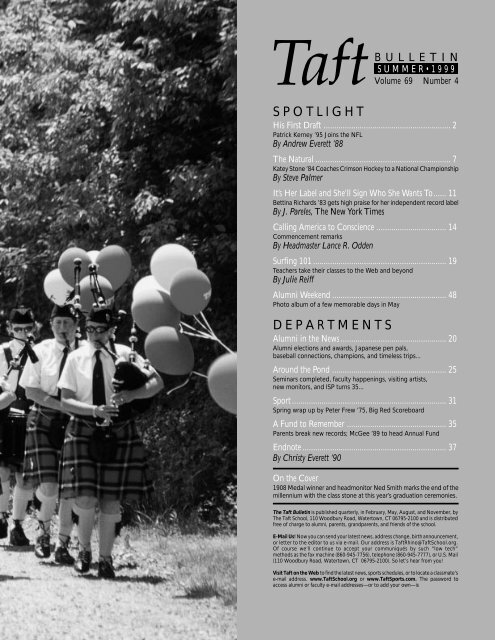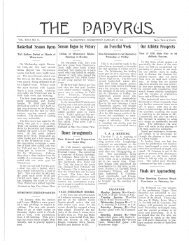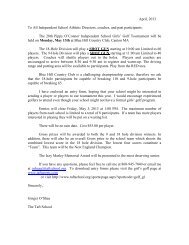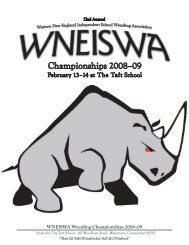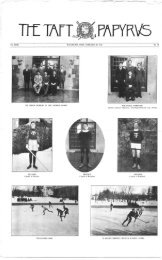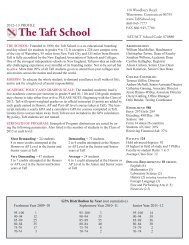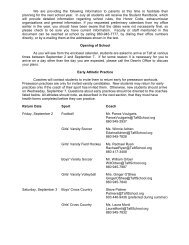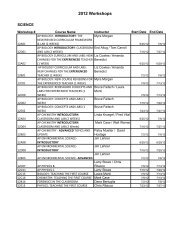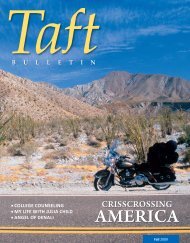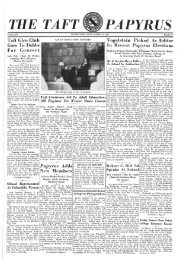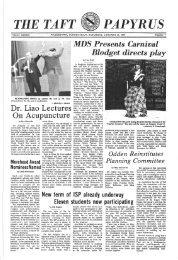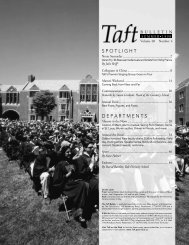spotlight - The Taft School
spotlight - The Taft School
spotlight - The Taft School
- No tags were found...
Create successful ePaper yourself
Turn your PDF publications into a flip-book with our unique Google optimized e-Paper software.
BULLETINSUMMER•1999Volume 69 Number 4S P O T L I G H THis First Draft ............................................................ 2Patrick Kerney ’95 Joins the NFLBy Andrew Everett ’88<strong>The</strong> Natural ................................................................ 7Katey Stone ’84 Coaches Crimson Hockey to a National ChampionshipBy Steve PalmerIt’s Her Label and She’ll Sign Who She Wants To...... 11Bettina Richards ’83 gets high praise for her independent record labelBy J. Pareles, <strong>The</strong> New York TimesCalling America to Conscience ................................. 14Commencement remarksBy Headmaster Lance R. OddenSurfing 101 ............................................................... 19Teachers take their classes to the Web and beyondBy Julie ReiffAlumni Weekend ...................................................... 48Photo album of a few memorable days in MayChip Spencer ’56,with the help ofthe Litchfield HillsPipes and Drums,guides the AlumniDay parade.D E P A R T M E N T SAlumni in the News .................................................. 20Alumni elections and awards, Japanese pen pals,baseball connections, champions, and timeless trips...Around the Pond ...................................................... 25Seminars completed, faculty happenings, visiting artists,new monitors, and ISP turns 35...Sport ......................................................................... 31Spring wrap up by Peter Frew ’75, Big Red ScoreboardA Fund to Remember ............................................... 35Parents break new records; McGee ’89 to head Annual FundEndnote .................................................................... 37By Christy Everett ’90On the Cover1908 Medal winner and headmonitor Ned Smith marks the end of themillennium with the class stone at this year’s graduation ceremonies.<strong>The</strong> <strong>Taft</strong> Bulletin is published quarterly, in February, May, August, and November, by<strong>The</strong> <strong>Taft</strong> <strong>School</strong>, 110 Woodbury Road, Watertown, CT 06795-2100 and is distributedfree of charge to alumni, parents, grandparents, and friends of the school.E-Mail Us! Now you can send your latest news, address change, birth announcement,or letter to the editor to us via e-mail. Our address is <strong>Taft</strong>Rhino@<strong>Taft</strong><strong>School</strong>.org.Of course we’ll continue to accept your communiqués by such “low tech”methods as the fax machine (860-945-7756), telephone (860-945-7777), or U.S. Mail(110 Woodbury Road, Watertown, CT 06795-2100). So let’s hear from you!Visit <strong>Taft</strong> on the Web to find the latest news, sports schedules, or to locate a classmate’se-mail address. www.<strong>Taft</strong><strong>School</strong>.org or www.<strong>Taft</strong>Sports.com. <strong>The</strong> password toaccess alumni or faculty e-mail addresses—or to add your own—is
HIS FIRST
S P O T L I G H TPatrick KerneyJoins the NFLBy Andrew Everett ’88While <strong>Taft</strong> has long been known for producing MDs, PhDsand CPAs, the class of 1995’s Patrick Kerney is making theschool’s first foray into the NFL.<strong>The</strong> Atlanta Falcons selected Kerney, a three-sport star at<strong>Taft</strong>, with the 30th pick of the first round of the 1999 NFL draft. Thatselection marked an amazing four-year run that saw Kerney go from alacrosse recruit and walk-on football player at the University of Virginiato a first-team All-American defensive end and a finalist for the BronkoNagurski Award, given annually to the nation’s best defensive player. Patrick Kerney’s combination of size, speed, and hard work caught the eye of UVA coaches. Kerney became a nightmarefor opposing quarterbacks. He tied the Virginia single-season sack record with 15 in 1998. Photo by Pete Emerson/UVADRAFT<strong>Taft</strong> Bulletin 3
S P O T L I G H T“He will have left a legacy here forother players to chase in terms of totaldedication to trying to improve himself,”Smith said. “<strong>The</strong> way I seePatrick, he’s just now learned how toplay the game so his real developmentis ahead of him. He compares most favorablywith a lot of (NFL) guys.”<strong>The</strong> Falcons, who felt fortunate tostill have Kerney around when they sehewas a leader on the team.”When Kerney showed up for preseason,though, their tune quickly changed.“When I got back from vacation inlate August,” Starsia said. “I was hopingthat Patrick would be in my office whimperingand crying and trying to get outof football practice. Instead, the footballcoaches came in and said, ‘Dom, I thinkhe’s the best prospect in the class.’”Starsia knew right there thatfootball’s gain would be his loss. Kerneyhonored his commitment to the lacrosseprogram for two seasons, buteventually the need to attend springfootball—not to mention the possibilityof a full scholarship—pulled himto the gridiron full time.As at <strong>Taft</strong>, Kerney’s unquenchabledesire and incredible work ethic madean immediate impression on the UVAfootball coaches.“<strong>The</strong> thing I liked so much abouthim is that he was starved to death tolearn football,” said Ty Smith, Virginia’sdefensive line coach. “When he realizedhe was beginning to learn somethings, his hunger for learning morewas just tremendous.”“Generally, when other guys werestanding around waiting for practice tostart, he would already be out on the fieldand get in 10 minutes of work before practiceactually started. And if we were in apart of practice where we were workingon special teams or something, he wouldgo over and work on individual skills.”As those skills developed, Kerney“If the Falcons need any more convincing about Kerney’s character, they just need to askany of the nine <strong>Taft</strong> friends—[standing] Tyler Tremaine, Peter Becker, Jonathan Evans,Patrick, Trevor Hanger, Jon Wright, Jamie McVicar, [front] George Cahill, Tony Pasquariello,and Brad Demong—who joined him for draft weekend.”became a nightmare for opposing quarterbacks.He tied the Virginiasingle-season sack record with 15 in1998, including three-sack gamesagainst Maryland and Florida State.His performance earned him firstteamAll America honors, considerationfor the Bronko Nagurski Award, andhigh praise from his coaches and NFLscouts alike.for other players to chasetrying to improve himself.”<strong>Taft</strong> Bulletin 5
S P O T L I G H Tlected at No. 30, couldn’t agree more.“I think that we got a qualityplayer,” Atlanta head coach Dan Reevessaid. “He has a tremendous motor. Hegoes full speed all of the time.”Added Falcons defensive line coachBill Kollar, “I didn’t think there was anychance we’d get the guy, but we’re reallypleased that we did. I think he’s a heckof a kid. You can’t get enough guys thatare not only good football players, butgood individuals—good human beingsthat are enjoyable to be around. Andsent the group an e-mail telling themhow much it would mean to him to havehis <strong>Taft</strong> buddies in attendance. He mayhave become one of the highest-profileplayers in college football, but Kerneyremains true to the friends that knowhim best.“Any time my head starts swellinga little bit and I start thinking that I deserveall this stuff, I look back at mysenior year at <strong>Taft</strong> and think where I wasand where I’ve gotten to,” he said. “Itbrings me right back down to earth.started making plans to get together againfor his first game as a Falcon.”For the recent college grads, therewill likely be a lot of talk at that gameabout entering the “real world” andstarting careers. Kerney, though, will bethe only <strong>Taft</strong>ie entering truly unchartedwaters.Andrew Everett ’88 lives in Seattle,Washington, and writes for NFL.com. Heis the son of Jol and Susan Everett, whoretired this year.“I think that we got aquality player.He has a tremendous motor.He goes full speedall of the time.”that’s the type of guy he seems to be.”If the Falcons need any more convincingabout Kerney’s character, they justneed to ask any of the nine <strong>Taft</strong> friends—Tony Pasquariello, George Cahill,Jonathan Evans, Trevor Hanger, TylerTremaine, Brad Demong, Brad Wright,Jamie McVicar, and Peter Becker—whojoined him for draft weekend.“It was a celebration of Patrick’s accomplishments,”said Demong, whodrove to Charlottesville from Burlington,Vermont, with Tremaine. “I was excitedjust to be there and be part of it.”Demong was initially concerned hemight get in the way during what wassure to be a busy weekend, but KerneyGuys who know me real well know thatI’m just a goofball; they always remindme that I’m a dork at heart.”Demong and Evans disagreed withthat assessment, saying, instead, thatKerney is a gentleman at heart.“<strong>The</strong> day after we got back fromCharlottesville, he sent us all another e-mail thanking us for sharing in one ofthe biggest days of his life,” Demongsaid. “He had been busy meeting withthe team and media in Atlanta, but hestill found time to thank us.”Added Evans, “After he got drafted,he wanted a photo of everyone in the backyard.He spent the rest of the day with aperpetual smile on his face, and we allHonoredAt UVa’s graduation ceremoniesin May, Patrick receivedthe John Acree MemorialTrophy, “given to that athletewho exemplified the highestqualities of leadership,cooperative spirit, andunselfish service in theinterest of athletics at theUniversity of Virginia.”6 Summer 1999
“<strong>The</strong> Natural”ECAC Coach of the Year, Katey Stone ’84,Coaches Harvard to a National ChampionshipBy Steve PalmerPhotographs by Justin Ide, Boston Herald
S P O T L I G H T<strong>Taft</strong> has had its share of “naturals,” those uniquely gifted athletes whodominate a season or succeed in any athletic arena, much likeRoy Hobbs, in Bernard Malamud’s classic baseball novel <strong>The</strong> Natural.One of the most gifted is Harvard’s ECAC Coach of the Year, Katey Stone ’84.Unlike Hobbs, who loses sight of his ideals, the simple concepts of dedication,persistence, passion, and team loyalty have defined Katey’s personalsuccess as an athlete and her current rise as one of the nation’s leading collegecoaches. <strong>The</strong>se are ideals generated at home, nurtured at <strong>Taft</strong>, and realized overthe years as a coach on her own, and they were a very important part of whatwas an unforgettable experience for her players at Harvard this year.Katey has enjoyed many personaltriumphs as an athlete [see below], butnone have stacked up to her experiencethis year as the head coach of theNCAA Champion Harvard women’sice hockey team. This past winter theHarvard women followed CoachStone’s formula to set a new standardfor success in college hockey, finishingwith a 33-1 overall record, the covetedECAC and NCAA championships, anda number 1 ranking in the nation.It was not easy, as both championshipswere decided by one goal in tenseovertime games; but, in the end, KateyStone and her team stood at the pinnacleof college hockey with a record of successthat places them side-by-side withthe most accomplished teams in Harvardhistory. In fact, Harvard boasts only threeNCAA championship teams: men’shockey in 1988-89, women’s lacrosse in1990, and now women’s ice hockey.<strong>The</strong> Family Legacy<strong>The</strong> Stone legacy goes back over three decadesat <strong>Taft</strong>. Few alumni have not heardof her father, Larry, a legendary baseballand football coach and long-time athleticdirector, or her sister, and two brothers,who were just as athletic as Katey herself.Katey came to <strong>Taft</strong> with athletic ideals alreadyin place, having grown up in themidst of athletic success.All four Stone kids enjoyed significantathletic careers at <strong>Taft</strong> and beyond:younger brother Jimmy ’83 went on toplay baseball at North Carolina and isSuccess is Written in StoneKatey’s own honors as 1999 ECAC Coach of the Year, as well as the team’sECAC title and national championship, are just another installment in the legacyof success that started long before her coaching career.Winning the Makepeace Award as <strong>Taft</strong>’s outstanding female athlete, Kateyearned eleven varsity letters in four years, playing field hockey, ice hockey, andlacrosse. Captaining all three teams, she set new standards for scoring on the iceand led the 1983-84 ice hockey team to an undefeated 17-0-1 record.She went on to be part of three national championship teams in ice hockeyand lacrosse at UNH and was captain for both teams.currently the athletic director at BlairAcademy; older brother Mike ’74 playedprofessional baseball and now coachesthe team at UMASS; and sister Kelly ’76went on to play three varsity sports atUNH and then to coach many championsat Hotchkiss.Katey vividly recalls the connectionbetween personal attributes, a coach’s passionfor the sport, and athletic successthrough her dad’s example: “My dadloved his career, and what a great exampleto his kids. He worked hard, enjoyed thesuccess, and left his job at the office.” Sheproudly gives credit to both her parentsfor passing on the “competitive spirit…that has driven us to excel.”Indeed, Katey’s future in sportsseemed to be set in stone, but that didnot leave any sense of entitlement or arrogancewhen it came to her own teamsand efforts. That was obvious when sheventured into the boys’ youth hockeyranks in the mid ’70s, the first girl todo so in the Watertown area. And, PatsyOdden remembers her as the first “impactplayer” for girls’ athletics at <strong>Taft</strong>.For the Fun of ItKatey Stone made a mark for herselffrom day one at <strong>Taft</strong> with her hard-drivingstyle and competitive seriousness.8 Summer 1999
S P O T L I G H TBut, according to Coach Odden, Kateyalso knew how to have fun playingsports: “She was a joy to coach, a verypassionate captain and athlete, but shealso made it great fun, for herself, thecoaches, and the whole team.”And this is something Katey hascarried with her into her coaching ca-reer; she views team camaraderie as anessential element to any successful program:“Even my college hockeyexperience reinforced for me that playersmust enjoy what they do in order tocapitalize on their talents.”This approach seems to be one elementto the great success of this year’sHarvard team, and both co-captain AJMleczko ’93 and assistant coach KateSchutt ’93 described their coach’s emphasison enjoying what you are doingas something central to Harvard hockey.<strong>The</strong> winter season can be a “long one,”said Mleczko, but Stone’s ability to“have fun and laugh is very importantGo Big RedDid you know that <strong>Taft</strong> Red was originally chosenas Harvard Crimson? An article in the <strong>Taft</strong>Papyrus during the school’s 50th anniversary describesthe selection. One of the first graduatingclasses decided to vote on school colors. <strong>The</strong>rewere ten graduates that year; the nine going toYale voted for blue. As the story goes, they feltsorry for their classmate bound for Harvard anddecided to add crimson. Thus the school’s officialcolors became blue...and red.As comfortable on the field ason the ice, “Natural” athleteKatey Stone ’84 throws out thefirst pitch at Fenway Park.Crimson’s assistant ice hockeycoach Kate Schutt ’93, farright, looks on.for the team’s state of mind and success.She has a very good personal relationshipwith her players.”Planning AheadHer hopes for the future have notchanged following this stellar seasonand national championship. With fourof the top five scorers in the nation,three returning for next year, KateyStone’s crew will be shooting for it all<strong>Taft</strong> Bulletin 9
S P O T L I G H TPatsy’s PlayersKatey wasn’t the only one with the Harvard team to cut her skates on MaysRink. Part of the Crimson’s success this year depended on four recent <strong>Taft</strong>graduates who each played a significant role in the season. AJ Mleczko ’93,Tammy Shewchuk ’96, Courtney Smith ’96, and assistant coach Kate Schutt’93 were also part of Patsy Odden’s Lady Rhinos.Co-captain AJ Mleczko ’93 and Tammy Shewchuk ’97 skated together allseason as two-thirds of the most formidable front line in college hockey—andalong with Canadian Olympian Jen Botterill, they have been described as thebest line ever in the college ranks. Certainly they are the most prolific in termsKatey Stone ’84, AJ Mleczko ’93, Patsy Odden, Courtney Smith ’96, Tammy Shewchuk’96, and <strong>Taft</strong> assistant coach Jessica Clark ’94. Photo courtesy of Bambi Mleczko.of scoring, with Mleczko 1st (114 pts.), Shewchuk 2nd (105 pts.) in the nationin scoring at the end of the season.Mleczko also won the Patty Kazmaier Memorial Award as the outstandingcollege hockey player in the nation. Also a crucial part of the team was former<strong>Taft</strong> forward Courtney Smith ’96, who made the transition to defense this yearat Coach Stone’s suggestion.Finally, another of Patsy Odden’s stars and a former head monitor at <strong>Taft</strong>,Kate Schutt ’93, finished with her playing eligibility, helped out on the benchas one of Katey’s assistants.“My connection to <strong>Taft</strong> is scattered throughout our roster,” said Katey,“and few prep school programs have produced more Division I collegehockey players.”again next winter: “<strong>The</strong> goal for thisprogram is to be contending for thenational title every year.” Her ambitionand determination are echoed by herplayers, as departing Mleczko sees thesuccess of this year’s team carryingover for several years to come: “CoachStone has created a cycle of bringingin good players who know how to enjoysuccess… hopefully it will becomesomewhat of a dynasty.”“You try to bring out the best ineach athlete, to exceed their expectations,and to achieve collectively withthe team,” Katey said. “Everyone wantsto succeed immediately, but it takestime, and over the past five years I havelearned to be more patient.”That is a crucial lesson not lost onher players. Even with former Olympiansand young talent as good asECAC Rookie of the Year JenniferBotterill and Tammy Shewchuk ’96,there will be plenty of competition outthere next year.Women’s ice hockey has exploded inpopularity, in the US and in Canada,partly due to the exposure from the Olympics.And, with Harvard’s success this year,Katey Stone has been busier than ever onthe phone, writing letters, and planningfor another campaign next winter.“I’ve had some of my best momentsgetting to know great people who happento be good hockey players,” saidKatey. You can be sure that the youngwomen skating for Harvard next yearwill be working just as hard, their passionand ambition mirroring that oftheir coach. But, if another nationalchampionship does not materialize,Katey Stone will be by their side, patientand supportive, reminding themof the value of dedication, trying yourbest, and having fun.Steve Palmer is a member of the EnglishDepartment and, as Patsy Odden’s formerassistant coach, is someone familiar withmany of Katey’s players.10 Summer 1999
It’s HerLabeland She’llSignWho SheWants ToBy Jon Pareles,<strong>The</strong> New York TimesBettina Richards ’83 started her own recordcompany, Thrill Jockey Records, in 1992.<strong>The</strong> company releases records she cares aboutand lets the musicians decide what to release,how to package it, and how to run their careers.Photo by Sam Prekop
S P O T L I G H TWhen Bettina Richards was an artist-andrepertoryexecutive for big recordingcompanies, she didn’t like the way theytreated musicians. Her favorite bands were ignoredif they weren’t best sellers; one lead singer, whowent on to make a gold album, was told he shouldn’tbe singing at all.“I wasn’t happy,” Ms. Richards said. “I wasmaking money, but I couldn’t talk to anyone aboutthe great show I saw last night or the great recordI found. It was a job.”“I wanted a companywhere the artists’expectations andthe labels’ abilitieswere in line…”So in 1992, she started her owncompany: Thrill Jockey Records,named after a gang of delinquents in aB movie. It would release music shecared about and let the musicians decidewhat to release, how to package itand how to run their careers. “I wanteda company where the artists’ expectationsand the labels’ abilities were inline,” she said. “I don’t think major labelsare inherently evil or out to destroythe world. I just don’t happen to usemusic that fits their system.”That music, Ms. Richards said, issimply “what I like.” Thrill Jockey is aleading outlet for what some criticshave named “post-rock”: instrumentalsthat elude categorization as jazz, poptunes, or dance music. <strong>The</strong> label’s bestsellingband is Tortoise, whose mostrecent album has sold nearly 100,000copies worldwide.But Thrill Jockey has also releasedalbums by the neo-Appalachian duoFreakwater, two women who sing abouthard times; the electronic group Oval,which has built compositions on thesounds of skipping CD’s, and the Nerve,a peppy alternative-rock band.“It’s kind of freaky, left-of-centerstuff that she puts out, but at the sametime there’s a big enough audience sothat she can make a living,” said NicHarcourt, the creative music directorof KCRW-FM in Santa Monica, California,and the host of the station’sMorning Becomes Eclectic, a programthat the music business on the WestCoast follows closely.In six years, Thrill Jockey has released60 albums (both as CD’s andold-fashioned vinyl LP’s), singles andEP’s. All but three releases have brokeneven or turned a profit. Bycontrast, 80 percent to 90 percent ofalbums from major labels post losses.But Thrill Jockey works on a grassrootsscale, seeking sales in thousandsrather than millions; its typical releasebreaks even with sales of 1,500 CD’sand 500 LP’s. And while ThrillJockey’s profit last year was probablyless than what Columbia Recordsspends on catering, it is a success storyin independent rock.Until last year, Ms. Richards, whois 33 years old, did everything herself,from signing talent to lining up bandinterviews. Now Thrill Jockey hasthree other full-time employees andone part timer and is about to buy itsown small building.12 Summer 1999
S P O T L I G H TMs. Richards started Thrill Jockeywhile working four days a week at PierPlatters, an alternative-rock recordstore in Hoboken, NJ. She ran the labelfrom her third-floor walk-upapartment on Avenue C in Manhattan,carrying mail-order CD’s toU.P.S. because she didn’t ship enoughto qualify for a pickup. Her businessadvisers were people who had startedtheir own labels. “I was constantly askingadvice from people: cheaper placesto press things, ways to cut corners,”she said. “One thing about independentlydistributed record labels is thatyou don’t get this competitive feeling.As long as you are willing to reciprocatewith information, people arehappy to give it.”In 1995, Ms. Richards moved fromNew York to Chicago, where her mainmanufacturer and distributor, Touchand Go, is based. Rent and taxes areconsiderably lower than they are inNew York, she noted.Many independent companies arestepping stones for bands that hope tobe discovered by major labels. By contract,the smaller labels then share inthe profits from the major-label releases.“I don’t want to spend my timeas a farm label,” Ms. Richards said.“From a business standpoint, it wouldbe better to have bands bound to contractsso I’d get a piece of their future.But I don’t want to make money froma system I don’t support.”Thrill Jockey makes unusually generousdeals with musicians. Once analbum breaks even, the label and themusicians each get 50 percent of thegross receipts. “When the net comesdown, they actually get more than me,”Ms. Richards said. Contracts are oftenliterally a handshake.Ms. Richards chooses bands that,she thinks, can benefit from the scaleof her company and will stay. “If becomingfamous is their primary focus,then we’re not the right label for them,”she said. “But if they want to continueto make music and live off that, thenthat’s a goal we can achieve.”Thrill Jockey records most albumsfor under $3,000, one three-hundredthof what a band like U2 spends,and advertises sparingly. Video clipstend to be made by friends of thebands or as projects by art students,though they have been shown occasionallyon MTV. Thrill Jockeydepends largely on the unpaid promotionof college radio stations andreviews in the press, but it also usesclub disk jockeys and skateboardingmagazines to reach consumers.“Each record is totally different,”Ms. Richards said. “It’s not as if I solda really great new garbage can or a niceclock. Your most popular band thisyear could be completely unpopularnext year. My company has to be flexibleand adapt.“I want my company to stay in businessand do well,” she said. “But thecreative stuff was always the motivationthat sparked it. It wasn’t, I see a way tomake money better. It was, I can makethis artist’s experience better.“This is a lot of work,” Ms. Richardsadded. “But it never feels like a job.”Reprinted with permission from<strong>The</strong> New York Times.“If becoming famousis their primaryfocus, then we’renot the right labelfor them…”“It’s kind of freaky, left-of-center stuffthat she puts out, but at the same timethere’s a big enough audience so thatshe can make a living…”<strong>Taft</strong> Bulletin 13
Calling Americato Conscience14 Summer 1999109th CommencementRemarks By Lance R. Odden, HeadmasterMay 29, 1999
S P O T L I G H TLeft:1999 <strong>School</strong> Monitors. Standing: Katie Percarpio,Molly Barefoot, Chuck Crimmins, Laura Stevens, AlexDickson, Peter Walke, Mythri Jegathesan, AndrewBostrom, Cathy Schieffelin, Ned Smith-head, KatieBienen, Jossie Green. Front: Kenny Clark, Taj Frazier,Eyram Simpri.Below left: Danielle Perrin received the Maurice PollakAward, the David Edward Goldberg Award for outstandingindependent work, as well as scholarships from theSiemon Company and the Watertown Foundation.Below center: Nicole Robertson is the first recipient of thenewly dedicated Harry W. Walker ’40 Non Ut Sibi Award.Below right: Stephen Dost needed help to carry hismany prizes home; he received the Mathematics andSpanish Prizes along with the David Kenyon WebsterPrize for Excellence in Writing, in addition to beingnamed joint valedictorian with Seth Caffrey.“If I don’t speak for myself,who will?But, if I speak only formyself, who am I?And, if we don’t speak up,who will?And, if not now, when?”—Rabbi HillelYour parents, grandparents, faculty,and I grew up in a time where theconstructs of morality were clearer,where the issues were large and certain, andwhere it was easier to choose goodness.Opposing fascism, communism, and standingup for civil rights for all Americanswere certainly easy issues compared to thetenuous and convoluted issues of our times.<strong>Taft</strong> Bulletin 15
S P O T L I G H TTop left: Seth Caffrey was named joint valedictorian,the first time in the school’shistory, along with Stephen Dost. Seth alsoreceived the Sherman Cawley Award inEnglish and the Bourne Medal in History.Above: 1999 Graduate Max Montgelas,front, with his sister, Caroline ’97, parentsRudy and Beth, and grandparents, Johnand Betty Dean.Left: Patsy Odden, Irene Chu, Lauren ’99,Lance Odden, Alex Chu ’66, and Jonathan.Your generation faces far more complexissues, where right and wrong maynot be the defining equation, wherethe choice may be between two values,which reasonable people can agree areimportant but chose differently, therebybringing themselves to be at odds.<strong>The</strong> controversy over abortion illustratesthis point. All of us would standbehind the woman’s right to control herbiological destiny, even as we would achild’s right to be born. <strong>The</strong> differencebetween us falls in the scientific andmoral dilemmas associated with conceptionand the beginning of life in utero.Tragically, the debate is cast in the larger,more absolutist terms of righteousness.In general, the majority of Americansavoid this controversy in public,holding our opinions to ourselves. Perhaps,we do not have clear convictions,but more likely because we do notwant to choose publicly between twocompeting rights.In the years to come such choiceswill expand significantly—the sanctity oflife versus the right to die, the drive formedical knowledge versus our historicaversion to genetic engineering, attentionto individual rights and accomplishmentversus affirmative action, the drive forenvironmental protection and the needto provide economic expansion for jobs,freedom of speech and our desire to protectyouth from pornography and theinfluence of violence, and on, and on.As we sit here today, one of the greatmoral crises of our lifetime is playingout, unexamined, undefined, and callinginto question the United States’ moralleadership of the world. Of course, Irefer to the crisis in the Balkans, Yugoslavia,and Kosovo.I put to you briefly just a couple oflarge questions. Why are we there? Is itfor moral or geopolitical reasons or is itjust politics or the polls? What is ourpurpose? What principles or policies ofinvolvement are being formulated for thefuture? Put another way, why did we decideto intervene on behalf of Kosovars,16 Summer 1999
S P O T L I G H TBill and Anne Kneisel with Jamie ’97 and Tyler ’99. Brenda and Bernie Percarpio with Robert ’98 and Katherine ’99.Anne, Meg ’95, Will ’99, Braden ’92, and Will Cleveland. Perry and Louise Cooke with Matt ’93, Nell ’99, and Peter ’98.and not the citizens of Rwanda? For asmall intervention there would havesaved tens of thousands of lives.<strong>The</strong> head of the United Nations,Kofi Anan, has pointed out that in bothworld wars and wars between nations inthe 20th century about 35 million peoplehave been killed. In contrast, 150 millionhave been killed in cold blood bytheir own governments in internal actionssimilar to those occurring in Yugoslaviatoday. Inevitably, these internal struggleswill continue, and we have to ask howthe United States will elect to make decisionsabout intervention in thesebarbaric struggles in the future, in yourlifetime. What principles guide us?Over the next four years, you havethe unique opportunity to explore theethics of life, your responsibilities as acitizen, and the responsibilities of ournation. Each of you will discuss and studythese topics, particularly as they are articulatedand defined in the disciplinesyou choose as majors.To this day, I interpret and try tounderstand the world influenced by theideas I learned at Princeton Universityin a course taught by George Kennan,one of the architects of our post-war containmentpolicy. You will have equivalentexperiences in biomedical ethics, in exploringissues of the media, race, gender,poverty, environmental and economicjustice. Your generation must make themost of your studies, for just as our worldhungers for a new definition of justice inthe conduct of foreign affairs, so too doesit for all the essential questions of living.Presently, American society is disengagedfrom matters of public policy, frompolitics. We have become a nation ofviewers or bystanders, unwilling to bepublicly involved in the difficult issuesof our times. Throughout American history,it has been our youth who havecalled us to conscience. You have learnedthis for yourselves in your study of thecivil rights movement of the ’50s and’60s, and the anti-war movements of the’60s and ’70s.<strong>Taft</strong> Bulletin 17
S P O T L I G H TChuck Crimmins and Class Speaker JossieGreen received the Joseph I. CunnighamAward, recognizing those who have“worked selflessly for the betterment ofthe entire school community.”Commencement speaker and retiring history teacher Jol Everett, right, receivedthe William and Lee Abramowitz Award for Teaching Excellence.Aurelian Award winner Laura Stevens andClass Speaker Taj Frazier.Advice from Jol Everett:First, make every effort to find and keep that special person you want to spendthe rest of your life with, because, for the most part, nothing is more fulfillingthan being happily married and raising a family.Second, make every effort to find a job after college that you will enjoydoing and that will give you a sense of accomplishment, for in the long run thatwill be more important than making a lot of money.Finally, here is a piece of advice given to me by my father just before I went off tocollege: In the four, or more, college years ahead of you, take advantage of all that yourcollege offers you but have fun doing it, for you will never have a second chance.And so, I challenge you over the nextfour years to begin to form your worldviews, your politics, and your sense ofright and wrong about the essential issuesof human justice. Never again willyou have the luxury of considering theseproblems in depth.Yes, I am urging you to take on thechallenge of calling America to conscienceonce again. We are far too complacent inour present prosperity. Our preoccupationwith human weakness and personal scandalat the expense of consideration of thelarger ethical issues of our time is of itselfinherently immoral.At <strong>Taft</strong>, you have been generous inspirit and principled in relations withothers. You have made this a great year,and ours, a better school.Going forward, you enter worldsmore self-segregated, more selfish, placeswhere there will not be the same sourcesof adult counsel and support, and whereit is going to be harder for you to remainas giving and idealistic as you have beenhere. I pray that you do so, for just asour world cries out for consideration andleadership on the large issues, so too doesit on the small matters of human decencyand care. How we treat others defineswho we are, which is why empathy—theability to put yourselves in the shoes ofanother person—is the simplest, surestroute to being a good person.This is what I hope for all of you—that someday you will be recognized forhaving done your part to make the worldjust a little bit better place. This you havealready done here; and now, I challengeyou to go forth and do so in a broader,more complex world.As you go forth, remember alwaysthe words selected by our founder,Horace <strong>Taft</strong>, who framed so wisely theresponsibility of each of us—non ut sibiministretur sed ut ministret—Not to beserved, but to serve. In helping others wefind ourselves. Remember this always,and you will do well for our world.Photography by Eric Poggenpohl18 Summer 1999
S P O T L I G H TSurfing 101Two teachers take their classes to the Web and beyond<strong>The</strong> Internet isn’t anythingnew to most <strong>Taft</strong>students, but the waysome teachers are using itin the classroom hasgiven the World WideWeb new meaning.Geography and historyteacher Fran Bisselleand astronomy andphysics teacher VolkerKrasemann have traded intraditional textbooks forelectronic resources,many of the them on theInternet. Along with externalweb sites, bothteachers have also writtentheir own “web pages”to present class materialin efficient and entertaining ways.“<strong>The</strong>re’s a lot of junk out there,”Volker said. “One of the things I do islocate some of the more meaningful sitesand help them to learn the difference.When they first start searching they’llcome up with thousands of sites for everythingfrom places that will sell youplots on the moon to university sites withthe most up-to-date information. I tryto speed that process up for them.”Traditionally, students read textbooks and analytical essays to get theirinformation. “Now there is the Web,where information is marketed tothem,” Fran said. “It combines persuasivemass-marketing-type tools—withcolor and images. It is easy for them tobelieve everything they see, thus thenecessity for teachers to learn how toVolker Krasemann and Fran [Bateman] Bisselle supplement traditional toolsof the trade with more electronic information. Photo by Eric Poggenpohl.deconstruct web pages.”“And you do this best by learninghow to construct them,” Fran said.Electronic research is an importantnew skill for today’s students, and Franmakes sure her students learn how to doit well. A major part of the geographycourse she designed (including sectionstaught by other members of the department)is the creation of a web page.Working in groups, students are requiredto research a given topic and to presentit, not through a traditional research paper,but in an interactive web page.“<strong>The</strong> advantage to web pages,” Fransaid, “is that students can connect relatedinformation in many ways.”In astronomy as well as in geography,another asset of web-based instruction isthat materials can be updated instantly.Unlike textbooks in whichinformation can becomeout-of-date overnight, theInternet offers teachersand students the opportunityto find the latestinformation.Another benefit ofelectronic texts is thatthey can be customizedfor specific courses. Nolonger do teachers haveto search for that one perfecttextbook. “I have toupdate my class presentations,which I do inPowerpoint, all the timeas new discoveries aremade in astronomy,”Volker said. “I couldn’tdo that with a textbook. I also created asample site for students to see what Iam looking for. It’s based on the StarWars movies, to get them interested.”“<strong>The</strong>re’s a lot of information outthere, and it’s changing the way studentslearn,” said Fran. “We need to teach studentshow to deal with the overload, howto evaluate information and make senseof it. So it makes sense that it’s also startingto change the ways we teach.”Peter Relic, president of the NationalAssociation of Independent <strong>School</strong>s, hassaid that “the dirty fingernails curriculumis as important as the technologycenter.” He is right, but it will be moreand more difficult to differentiate betweenthe two as time passes.—Julie Reiff<strong>Taft</strong> Bulletin 19
ALUMNI IN THE NEWSAlumniIN THE NEWSNew Alumni TrusteeKen Pettis ’74As a four-year student at <strong>Taft</strong>, Ken participated inband, the Annual, and Masque and Dagger Society.In addition, he was a corridor monitor and amember of the Committee on Student Life andthe Press Club. Ken wrestled for the varsity fortwo years and also played lower school and j.v.baseball as well as j.v. squash. After <strong>Taft</strong>, Ken went on to Brown,where he graduated with an AB in Economics in 1978.Following Brown, Ken spent eight years with Bankers TrustCompany of New York. He left his position as vice president andmoved to Chase Manhattan, where he worked for eight years as avice president and senior structured sales officer in syndications.In 1990, Ken joined Barclays Bank PLC, where as director andsenior structurer he was responsible for structuring transactionsfor clients in the telecommunications industry. Until recently,Ken was a vice president in loan syndications for JP MorganSecurities in the field of media and telecommunications.Since 1992, Ken has been the co-founder and presidentof both the Hillcrest Road Block Association and the HillcrestNeighborhood Association in his hometown of Maplewood,New Jersey. He joined the Maplewood Zoning Board of Adjustmentin 1993 and is also a member of the MaplewoodCitizens Budget Advisory Committee. In 1996 he was a foundingmember of the Maplewood/South Orange (MSO) RacialBalance Task Force. He is also a member of the Board ofTrustees of the MSO Community Coalition on Race and aco-chair of the Coalition’s Ordinance Committee. In addition,Ken is an editor of the group’s newsletter. In 1998, Kenjoined the Outreach/Role Model program for male studentsof color at Maplewood Middle <strong>School</strong>.Ken and his wife, Karen, have a daughter Kendra, age 11,and a son Kristian, age 5. Currently, Ken is embarking on a majorcareer change after twenty years in the banking industry. Heand Karen are setting up their own furniture repair, restoration,and refinishing business in Maplewood. Ken’s other interests includecivic activities, freshwater tropical aquariums, woodworking,gardening, amateur bodybuilding, kiting, and golf.Walker PrizeEstablishedSome graduation prizes are anhonor in themselves, some carry alittle extra funds for college, butfor the first time at <strong>Taft</strong>, one awardwill go to help a charitable cause.<strong>The</strong> school’s Non Ut Sibi awardis amended this year to honor Harry Walker ’40, whose gifthas “transformed this award to make it one of the most importantof Commencement,” according to Headmaster LanceOdden, “making it a true inspiration to the community.”<strong>The</strong> Harry W. Walker Non Ut Sibi Award recognizes asenior whose service to the community outside <strong>Taft</strong> best exemplifiesHorace <strong>Taft</strong>’s motto, Non ut sibi ministretur sed utministret. “Give them a prize now,” Harry said, “and for therest of their lives the prize will be to serve other people.”Nicole Robertson ’99 is the first recipient of the newlydedicated award, which gives $250 to the student for hereducation and $750 to the charity of her choice. Nicole, whospent much of the year raising awareness of and funds forbone marrow transplants, designated her gift to the New EnglandMarrow Donor Program.Community service is a way of life for the Walkers, somethingtheir families have believed in for generations, acommitment that serves as a legacy for their children and theirgrandchildren. “People play tennis and golf all their lives,”Harry told the Westover <strong>School</strong> magazine, where he and hiswife, <strong>The</strong>a, created a similar prize. “<strong>The</strong>y’re what we call lifesports. Well, community service should be a life sport, too. It’ssomething you’re going to do for the rest of your life.”Harry has chaired Piedmont College’s Board of Trustees,served on the board at <strong>Taft</strong>, on the Yale DevelopmentBoard, the YMCA, and for a hospital in Sao Paulo, Brazil.He was a director of both the Rotary Club and the VisitingNurse Association. He continues as secretary of the YMCABlue Ridge Assemblies in North Carolina. “This is somethingwe do,” he said. “We feel it is important.”20Summer 1999
ALUMNI IN THE NEWSCitation of MeritDon McCullough ’42 was honored with this year’sAlumni Citation of Merit. <strong>The</strong> following tributewas delivered at the Alumni Luncheon in May.“At age sixteen, a <strong>Taft</strong> graduate, heading off toYale, your commitment to strive for the best wasearly in evidence in your singular accomplishmentsas a school monitor, letterman in football and track,and undefeated wrestler. In a lifetime of corporateleadership, you built one of the nation’s great enterprisesand advised others of equal stature. As anofficer in the United States Navy, trustee of PhiladelphiaCollege, director of the Boys and GirlsClubs of America, and trustee of the Boy Scouts ofAmerica, you have given selflessly of your energiesfor the benefit of others. To your alma mater, youhave given more, much more.Donald F. McCullough, you have sailed yourbeloved <strong>Taft</strong> into an astounding new era. As a trusteespanning four decades and board chairman for thenineties, you stood boldly at the helm, steering acourse that transformed and beautified our campus,generated a more than ten-fold increase inendowment with the unparalleled success of theCampaign for <strong>Taft</strong>, and affirmed <strong>Taft</strong>’s preeminenceamong independent schools. All this you have donewith your characteristic charm and sparkle in theeye. Mentor and friend, you have nobly embracedand fulfilled Horace <strong>Taft</strong>’s most cherished wish forhis students: Non ut sibi ministretur sed ut ministret.Today, with affection, gratitude, and admiration,we bestow upon you <strong>Taft</strong>’s highest honor, theAlumni Citation of Merit.”Yale Honors Will Hitchcock ’82Yale honored six faculty members thisspring as outstanding teachers, amongthem Will Hitchcock ’82, an assistantprofessor of history. Will received theSarai Ribicoff [Yale ’79] Award for theEncouragement of Teaching at YaleCollege. <strong>The</strong> citation honors Will forhis renown among students as a masterfullecturer, a superb seminar leader,and a devoted advisor.According to the citation, his “lectureson modern European diplomatichistory are models of clarity and organization—brightenedwith unexpectedhumor and enlivened by uncanny impersonationsof such figures as WinstonChurchill and Charles De Gaulle. In variousseminars focusing on the experiencesof Europeans as colonists on other continentsor as victims of occupation duringthe Second World War in their owncountries, [he] makes all [his] studentsfeel the importance of formulating andexpressing their own points of view.“Students in [his] classes feel inspirednot just to study harder, but tolearn more. As one of them remarked,‘he has taught us how to be historians’and ‘left us excited by the prospect ofresearch.’” His example as a scholar andhis “reputation for friendliness andhelpfulness” have brought him an unusualnumber of senior essay advisees,who respect him for the high standardshe sets and praise him for the “manyways in which he helps them meetthose standards.”Source: Yale Bulletin & Calendar<strong>Taft</strong> Bulletin 21
ALUMNI IN THE NEWSYuko Tojo Iwanami, granddaughter of General Tojo,is greeted by ex-marine Corydon Wagner ’43 atSeattle-Tacoma International Airport. Photo byBarry Wong/<strong>The</strong> Seattle TimesOf Pain and PenpalsCordy Wagner ’43, an ex-marine who lives near Tacoma, Washington,played host in April to the granddaughter of General Hideki Tojo, theJapanese wartime premier who ordered the attack on Pearl Harbor.<strong>The</strong> friendship is an unlikely one: Yuko Tojo Iwanami long harboredill feelings toward the U.S.-led Allies who executed her grandfather forwar crimes; Cordy saw some of the fiercest action of the Pacific at Peleliuand Okinawa [“Cordy’s Ridge,” Winter 1996] and lost many friends atthe hands of the Japanese.Six years ago, Cordy went back to Peleliu to find the last Japanesecommand post of that battle. Inside, he found the bones of two Japanesesoldiers who had committed suicide rather than surrender. <strong>The</strong>y had beendiscovered since the war, but never moved. Cordy arranged to have thebones returned to Japan.<strong>The</strong> gesture led Iwanami to write to Cordy and express her gratitude.An exchange of letters began. During that time, Iwanami’s heartsoftened toward Americans. She was touched by Cordy’s “largemindedness,”she said.Reconciliation is the reasonable response of responsible people,”Cordy said. “Humanity and feelings for people ultimately win outover hate.”“For a long, long time, the war was so horrible you never thoughtabout it,” Cordy told the News Tribune. “Now, I think about it a lot. Ithink about it almost every day. You think about the friends you madeand lost.” He said his friendship with Iwanami prompted some soulsearchingat first: “I never would have dreamt this. I just kind of have tohold myself back and thinkit through—am I being disloyalto my beliefs or friendsthat I served with?” ButCordy said he’s convincedthat his friendship withIwanami can serve as an exampleof how bitter foes canreconcile, regardless of whathas happened in the past.“We’re a small, shrinkingworld,” he told the SeattleTimes. “We must get alongbetter than we have in the past.<strong>The</strong>se episodes maybe arethere as part of some grand design….<strong>The</strong>re’s some healingin all this. <strong>The</strong>y used to be theenemy. It’s a wonderful end toWorld War II for me.”Jonathan Read ’74, chairman of Park Plaza Worldwide Hotels, meets with Yasir Arafat thisspring to sign a joint venture for five hotels in Palestine.Source: Jake Batsell, SeattleTimes, and Dani Dodge,<strong>The</strong> News Tribune22 Summer 1999
ALUMNI IN THE NEWSVirginia LacrosseWins NCAA TitleWhen the University of VirginiaCavaliers won their first NCAA DivisionI men’s lacrosse championshipthis spring—the first since 1972—two of <strong>Taft</strong>’s finest were at the heartof it all: Courtland Weisleder ’95 andDave Jenkins ’97.<strong>The</strong> number 8 seeded Cavalierswere 13-3 when they downed seventimechamp Syracuse in front of acrowd of 25,000. Virginia won thegame 12-10, despite five consecutivegoals in the fourth quarter by Syracuse.Courtland is a member of thedefense, and Dave plays midfield.Dave, a sophomore, is theteam’s lead face-off man, finishingsecond in the nation with a 64 percentrecord, and led the team inground balls with 91. “In the lasttwo years of David’s career he couldplay an even bigger role for us,”Coach Dom Starsia told the DailyTranscript. “He will play an importantrole in our program. He’salready a leader—more in deed thanin word right now, but that too willcome as he gets older.” Court madethe NCAA All-Tourney team.William DeWitt P’86, Darren Bragg ’87, and Lance Odden at spring training in Florida.Spring training with the Saint Louis Cardinals in Jupiter, FL. From left, William DeWitt III ’86,Edward Travers ’86, Darren Bragg ’87, and Winston Lord ’87.<strong>Taft</strong> is Cardinal RedMost people know that Mark McGwire plays for the St. Louis Cardinals, but howmany know the two <strong>Taft</strong> grads that are part of the organization? Darren Bragg ’87was signed this spring after appearing in 129 games with the Boston Red Sox.Darren, a left-handed hitting outfielder, has career totals that include a .261batting mark, 30 home runs, 175 rbi, and 38 steals in 469 games played. He wasoriginally drafted by the Seattle Mariners in 1991.Elsewhere in the St. Louis organization is Billy DeWitt ’86. Billy serves as headof business development and merchandising for the Cardinals. Also connected tothe <strong>Taft</strong> family is Billy’s father, William DeWitt, the Cardinals’ principal owner.<strong>Taft</strong> Bulletin 23
ALUMNI IN THE NEWSA Sound TripAndy Larkin ’64, a Varsity Club Hall of Famer who owned the six seat inHarvard’s undefeated 1966, 1967, and 1968 heavyweight varsity crews,lives in Northampton, Massachusetts. This spring, he wrote of his trips onthe Connecticut River for Harvard’s rowing newsletter, first to Long IslandSound; years later, down river and on to Mystic, Connecticut.After packing his bags with extra clothing, a tent, food, and water, andstowing an extra pair of oars in his Alden ocean double, Andy set out to row“gently down the stream.”“When I passed the point where I usually turned back,” he wrote of hisfirst trip, “there was a sense of newness, uncertainty, and exhilaration.” Afternearly missing a takeout at the Enfield dam, Andy experienced his firstwhite water rowing experience in the miles of rapids that followed, butmade it safely to the Sound.In 1995 and 1996 he extended the trip to reach his sister’s house inMystic, a total of 110 miles. In 1997 he made the trip again, but this timewhen he reached the Sound he was met with 3- to 4-foot swells and a tailwind, the landing point engulfed in surf. <strong>The</strong> chop increased and theboat swamped and capsized, throwing him into the water a half-mile fromshore. Fortunately the boat did not sink and the oars stayed with it. “Lifebecame very simple,” he wrote. “I had the rest of my life to row ashore,and happily I did.”“Had John Small been alive when I did my trips to Mystic,” Andyadds, “I most certainly would have stopped in at his home in GrotonLong Point. I could imagine landing at the beach and walking to hishouse to say hello. He was certainly instrumental in my rowing career.Years earlier, John and I had rowed the same waters when I first had myAlden and took it over to Groton Long Point to row with him. I canthink of few people with whom it would be more pleasant to share theadventure I would have been completing.”Source: Harvard Rowing NewsletterHeritage SculpturePete Peterson ’54 co-founded a new venturethis year with celebrated sculptor WillReimann. Together they have created HeritageSculpture, whose line of beautifully detailedbas-relief panel carvings debuted at Boston’sNew England Flower Show in March.“I was initially drawn to Will Reimann’ssculptural artistry as a collector,” Pete said.“A shared passion for cultural diversity andancestral history led to our current collaboration.We believe there is great promise forenduring art of cultural significance.”<strong>The</strong>ir unique works for the home or gardenare rendered in granite, slate, or glass frompatterns, mythical imagery, and icons as diverseas the cultures they represent.Pete lives in Acton, Mass., and is theCEO of Digital Products, Inc.Andy Larkin ’64 heads down the Connecticut River.24 Summer 1999
AROUND THE PONDpondSenior SeminarsNicole Robertson’s blood and bone marrow drive [see Spring ’99] was only oneof the new senior seminar projects to make news in the area. Sixteen students inthe program presented their final reports in May to review panels made up offaculty students and outside experts in the field. Below are two more newsmakers.Stevens Becomes EMTSenior Laura Stevens, daughter of Lindaand Richard Stevens ’69 of Middlebury,CT, has recently become an EmergencyMedical Technician.Since September, Laura attendedclasses every Monday night and almost everySaturday afternoon for four hours. Atotal of 120 hours of training are requiredto prepare for the practical and a writtentests necessary for EMT certification.<strong>The</strong> training consists of lectures oncardiac emergencies, respiratory emergencies,soft tissue injuries, and spinal injuries,and practice treating emergencies bysplinting bones, stabilizing people on longboards, and administering oxygen.“I had the idea to take an EMT classlast spring,” Laura said. “Being an EMTis something I’ve always been interestedin because one of my parents’ friends wasan EMT, and I was fascinated by it evenwhen I was little. I didn’t think I wouldhave a chance to take the class anytimesoon until I heard about the senior seminar,so then it all just worked out.”“I didn’t always like having to connectthe work in my [EMT] class to workhere at school. I felt the EMT class wassomething I was doing for myself and forpeople outside of <strong>Taft</strong>. It was hard tohave eight additional hours of class a weekand then be expected to hand in journalentries or a paper about my work. But Idid become interested in critical incidentstress debriefing while I was writing my21-page paper for the seminar; this is atopic I would have otherwise neverlearned about and it was interesting.”Laura is certified now. She passedthe practical exam and the written exam.She plans to join the student-run ambulanceservice at Brown University, whereshe will be a student this fall.“I am really excited to work withother EMTs,” Laura said, “and to helppeople who are injured or in pain. <strong>The</strong>reason I wanted to get into this work isthat I don’t like feeling helpless when Isee people who are injured. I want to beable to help people if I have the chance.”Source: Michael Blomberg ’00, <strong>Taft</strong> Press Club Laura Stevens, left, prepares for herEMT certification as part of her seniorseminar fieldwork.
AROUND THE PONDThreads of Meaning, Stitches of HopeTwo years ago, when <strong>Taft</strong> seniors JillGiardina and Nell Cooke felt that the<strong>Taft</strong> community was sorely lacking inAIDS awareness and education, they didsomething about it; they founded TAAP:<strong>Taft</strong> AIDS Action Program.Since then, with the help of theschool’s chaplain, Mr. Michael Spencer,and a spirited group of 36 students, theirefforts have culminated in the arrival ofthe AIDS Quilt on April 20.<strong>The</strong> program of events TAAP createdaround the quilt’s visit was titled“Threads of Meaning, Stitches of Hope,”According to Jill, TAAP was bornto provide education as a kind of preventivemedicine for AIDS: “We learnedthat our age group (18-25) is the mostat risk, and that by preparing theyounger generations, we can avoid problemsin the future.”Last year, with the help of Mr. Spencer,Jill and Nell began the arduousprocess of applying to the National High<strong>School</strong> Quilt Program in hopes of gettingsections of the Quilt to <strong>Taft</strong>. Sincefew private secondary schools have displayedthe Quilt, TAAP was thrilled tolearn that their detailed proposal hadbeen accepted.<strong>The</strong> AIDS Memorial Quilt is the largeston-going community arts project inthe world. Each of the over 41,000 colorfulpanels in the Quilt was made toremember the life of a person lost to AIDS.Panels are 3 feet by 6 feet—the size of ahuman grave—and there are 8panels in each 12 x 12 ft. sectionof the Quilt. As theepidemic claims more lives, theQuilt continues to grow.Two sections, or 16 panels,were on display at <strong>Taft</strong>. Inconjunction with the Quilt’sarrival, a number of eventswere planned, including thepresentation of <strong>Taft</strong>’s own twoquilt panels and the plantingof trees in memory of <strong>Taft</strong>alumni, Al D’Ossche ’69 andRuss Pais ’66, who died ofAIDS. Guest speakers, discussionpanels, music, and adance performance were alsoscheduled that week.“Though there are manyaspects of AIDS that should beconveyed to youth, the mainone that Jill and I have triedto focus on,” said Nell Cooke,“is that it can happen to you.”Seniors Jill Giardina and Nell Cooke and Chaplain Michael Spencer prepare to hang the two sectionsof the AIDS quilt on display at <strong>Taft</strong>. Photo by Mike Healey ’99Source: <strong>Taft</strong> Press ClubFacultyComings,Doings,and GoingsNew FacultySarah W. DickinsonB.A., DartmouthTeaching fellow in biology.Laura E. HarringtonM.F.A., Muhlenberg, SyracusePhotography.Previously adjunctprofessor at Syracuse.Michael D. HillPh.D., Howard, HarvardEnglish.Graduated Phi Beta Kappafrom Howard; receivedDistinghuished TeachingAward at Harvard, 1996.David B. Hinman ’87Ed.M., Hobart,Boston UniversityAdmissions, mathematics.Previously at RippowamCisqua for six years.26 Summer 1999
AROUND THE PONDYear-LongSenior Seminars[For more information, see “For theLove of Learning” Spring 1999] Taj Frazier with his panel expert,Yale Chaplain Jerry Streets.Kate Bienen ............................................................................ <strong>The</strong> HolocaustAndrew Bostrom ..................................................... Christian Faith in ActionCharles Crimmins .............................. Minority Students at Boarding <strong>School</strong>sTaj Frazier ........................................... Black Americans’ Conversion to IslamDanielle Perrin ........................................................................Music <strong>The</strong>rapyNicole Robertson ............................................ Bone Marrow TransplantationPeter Walke ..................................................................................... WetlandsLaura Stevens ........................................Critical Stress in Emergency WorkersSarah Sicher ......................................................................... Women in IslamBea Ogden ............................................................. Environmental EducationLauren Henry ................................................................. Self-Esteem in GirlsJulie Marmolejos ..................................................... Latino Culture in the USEmily Lord ........................................................................................... TwinsCathy Schieffelin ........................................ Manic Depression and CreativityJill Giardina ......................................................................... AIDS AwarenessMichael DeMarco ................................................................... Scripts in FilmEveretts RetireAfter 31 YearsOver 200 alumni, parents, andfriends joined Jol and SusanEverett at their retirement dinnerin Riverside, CT, on May 13.<strong>The</strong> Everetts, who came to <strong>Taft</strong>in 1968, were surprised by thepresence of their daughter,Christy ’90, and son, Andrew ’88(both of whom have articles inthis issue), who flew in from Seattlefor the occasion.In BriefDance WorkshopDance master Richard Hill, a guestfellow at Yale University andmaster teaching artist with theConnecticut Commission on theArts, gave a two-hour master classin Salsa dance. <strong>The</strong> workshop, heldin the Woodward Dance Studio,was open to the entire <strong>Taft</strong> communityas well as to dance students.Richard Hill has researched andtaught African and Caribbean music,dance, and culture for twentyyears and did extensive field workin Ghana and Haiti.Piano ConcertWorld famous Hungarian pianistGyörgy Oravecz gave a solo pianoconcert in Bingham Auditorium onApril 19, performing music byChopin, Liszt, and Bartók. Hespent the afternoon giving a pianoworkshop for <strong>Taft</strong> students.Choir Visits<strong>The</strong> Occidental College Glee Club,with Chris Eanes ’94, traveled fromCalifornia to perform in the ChoralRoom on Tuesday, May 18, as partof their East Coast tour. Chris, whorecently graduated with a degree inchoral conducting, conducted twoof the songs on the program, includingone with the vocal offshootgroup, <strong>The</strong> Accidentals, which Chrishelped form this year.Ellen B. HinmanM.A., Dartmouth,Boston CollegeClassics, assistant directorof college counseling.Previously at RippowamCisqua two years.Steven M. LauferA.B., HarvardTeaching fellow in physics.Andrew D. McNeillM.A.L.S., Lawrence, WesleyanCo-director of collegecounseling.Previously worked forLawrence University,<strong>The</strong> Gunnery, and Choateas college counselor.Holly H. McNeillM.S. Ed., University ofPennsylvaniaAdmissions.Previously worked atCanterbury and at Choate;worked at <strong>Taft</strong> in admissionsand as class dean from 1989-97.Juan A. Ortiz BulnesM.A., Universidad Autonomade Madrid, SpainSpanish.Taught at American <strong>School</strong>of Madrid for 16 years;here for one year to coverBaba Frew’s sabbatical.<strong>Taft</strong> Bulletin 27
AROUND THE PONDVisiting ArtisitHans Neleman, a commercial photographerfrom Holland who lives andworks in New York City, came to workwith <strong>Taft</strong> students on April 8. He iswell known for his majestic lightingtechniques, and the majority of hiswork is still life compositions focusedon the advertising industry. His clienteleincludes many diversecompanies such as Eastman Kodak,Levi’s Jeans, Macworld, and <strong>The</strong> Gap.He has also directed several videos forthe musical group Toad the WetSprocket and various artists for MTVEurope. He has begun to dabble inthe area of film direction and production.His current body of work is agroup of portraits of the Maori nativesof New Zealand.Poole FellowsSixteen <strong>Taft</strong> students received PooleFellowships this spring. Grantsranged from $500 to $3,000 dependingon the scope of the projects,which range from a two-week glacierstudy in Iceland to three weeksreforestation in Costa Rica and threeweeks community service in Fiji.Students receiving fellowships arerising seniors Sarah Barnes, AdrianaBlakaj, Lauren Bonenberger, BlakeDiMarco, Jason Donahue, LisaEhrlich, Harold Francis, SamanthaHall, Kathleen Liu, JanelleMatthews, Avery Moore, KathrynParkin, Scott Rickards, JoannaWolffer, and Paul Zhang, and risingupper middler Alex DiCicco.Spring in NepalEmily McNair ’99, left, sari shopping with a friend.Emily McNair ’99 also took a new approachto senior year. By completing allgraduation requirements at the end of thefirst semester, along with the senior seminar,Emily was able to spend much of thespring term teaching English in Nepal, oneof the poorest countries in the world.Inspired by a summer 1997 communityservice project she participated inthere, Emily contacted her friendShankar and said, “I want to come toNepal for three months. What can I do?”“Being with a group can be cultur-ally isolating,” Emilysaid, wanting to travelon her own this time. “Ihad a wonderful timewith 16 of the most fascinatingpeople I’veknown, but I didn’twant a group umbrellaover me the whole time.<strong>The</strong>re were moments Iwondered what I wasdoing though.”Emily traveled for amonth before starting toteach, meeting moreNepalese people andEuropeans who hadbeen in the countrylonger. One familypractically adopted herand took her to allthe relatives’ weddingswhile she was there.“Family is the most importantthing in Nepal.”Through her new contactsshe found “the mostamazing school”—the Blue Sun <strong>School</strong> inKathmandu. For the next two months shetaught 15 students who ranged in agesfrom 2 to 10 years old. “<strong>The</strong>re are over 36recognized languages and distinct dialectsin Nepal,” she said, so conversing with herpupils was occasionally a challenge.Yet, her experiences were not allpositive. Walking with a friend early onemorning, the girls were approached bya woman and her young daughter.“Lanas Sita,” the woman called, holdingthe girl out to them. Learning fromCharles A. ParkerA.B., PrincetonTeaching fellow in history.Elizabeth U. SchenkA.B., PrincetonTeaching fellow in computerscience and mathematics.Lindsay B. Stanley ’93B.A., VanderbiltTeaching fellow ineconomics and mathematics.Lynette Sumpter ’90A.B., BrownAdmissions, psychology,diversity planning.Has worked in businessand as a facilitator andinstructor at <strong>The</strong> WightFoundation for four years.NoteworthyLaura Erickson has beennamed head of the ScienceDepartment at <strong>Taft</strong>,replacing Bill Zuehlke(see Departures).Jack Kenerson ’82has been chosen to headthe History Department,following Jol Everett’sretirement.28 Summer 1999
AROUND THE PONDa passerby that she wasasking them to take herdaughter with them, “Ithit us in the face that shesaw this as the only wayfor her daughter to havea decent life.”Emily is already thinkingabout going back.“I’d like to work for awomen’s group there, startingsmall businesses, suchas soapmaking, to help raisetheir status and their levelof independence.”Shristi, Raj, and Swapnil at the Blue Sun <strong>School</strong> in Kathmandu.Study Published<strong>The</strong> results of a study by <strong>Taft</strong> facultymember Mennette DuBose San-Lee’87 are soon to be published by theNational Association for College AdmissionCounseling as part of itsMIAPTA Monograph Series. Focusingon three independent schools, thestudy looked at the social and intellectualcoping methods Black andHispanic students use in their transitionto college. “Minority seniors weresimilar to their majority peers,” shewrote, “in the range and average ofquantitative predictors of college success;they differed in the number ofcolleges they applied to and perceiveddifficulty of the application process.”THE WOODLAND SCHOLARS, Larry Allen, conductor, performed in theChoral Room on TUESDAY, APRIL 13. This professional choir of 16 voicesfrom Hartford presented a one-hour concert of choral masterworks, whichconcluded with a piece sung jointly with <strong>Taft</strong>’s own Collegium Musicum.Day of Service<strong>Taft</strong>’s fifth annual Community ServiceDay was held in April this year, insteadof the fall. One new feature this yearwas “kids’ community day” in which150 Watertown children came to campusto learn a little about pottery,theater, physics, weather, soccer, andother activities organized by <strong>Taft</strong> students.Other <strong>Taft</strong>ies spent the daycleaning up a vacant lot in Waterbury,clearing brush in the town cemeteryand junior high, planting flowers, helpingwith the local foodbank, andhelping other community organizations.“I think our kids gain as muchas anybody,” Jean Strumolo Piacenza’75, event organizer, told the WaterburyRepublican. “It helps themunderstand that there are people forwhom life is a lot more complicated.”Fran [Bateman] Bisselleis head of the Western NewEngland Prep <strong>School</strong> FieldHockey Association.Jean Strumolo Piacenza ’75earned her MSW at theUniversity of Connecticutin May.Dean of Academic AffairsBill Morris ’69 has beennamed head of the Boardof Trustees at St.Margaret’s-McTernan<strong>School</strong> in Waterbury.DeparturesJol and Susan EverettRetiring to Cape Cod.Mark DavisDirector of College Counseling,Phillips Exeter Academy.Bill and ElizabethKerney Zuehlke ’82Maine Coast SemesterProgram at Chewonki,where Bill will be headnaturalist.<strong>Taft</strong> Bulletin 29
AROUND THE POND<strong>School</strong> MonitorsHead monitor Ned Smith ’99 and Headmaster Lance Odden welcomerising head monitor Price Bell ’00. Other school monitors are EmilyBlanchard, Ribby Goodfellow, Meredith Morris, Keely Murphy, KimNoel, Tim Pettit, Jessup Shean, Emily Smith, Nicole Uliasz, DemetriusWalker, and Ryan Byrnes. Photo by Vaughn WinchellRock of AgesWorkers clearing brush in the Mattatuck StateForest this spring came across a vine-hiddenbronze tablet dedicated to Harley Fish Roberts[assistant headmaster and part owner of theschool with Mr. <strong>Taft</strong>]. Roberts was instrumentalin preserving the land, which lies on theWatertown/Thomaston line, and donating itto the state [“Hooray for Harley’s Woods,”Spring 1995]. <strong>The</strong> plaque, mounted in a stoneoutcropping over 20 feet high, once graced theentrance to Black Rock State Park and the adjoiningstate forest. <strong>The</strong> entrance was moved atleast thirty years ago, when Route 6 was rerouted.Although we knew the monumentexisted, its now-wooded location was unknownand few had any idea of its actual size.35th Anniversaryfor IndependentStudies Program<strong>The</strong> Independent Studies Program held its annualspring exhibit on May 13. <strong>The</strong> ISP, now inits fourth decade, offers the chance for studentsto pursue interests outside of the curriculum.<strong>The</strong> exhibit is the culminating event andan extraordinarily exciting time for the school;the completed projects are eagerly awaited. Studentsand faculty come by the score—indeedaudiences have been over 100 in many cases—to hear a recital, see a photo exhibit, watch thelaunching of a rocket, observe a student-builtlaser, or hear a poetry reading.“Projects are less ambitious than senior seminars,”explains director Barclay Johnson ’53,“because an ISP student takes on the project inaddition to a full course load. <strong>The</strong> project receivesno credit, and so participants have theright to fail, which is very important to the program.It’s impressive what these students havedone. Barbu Mateescu ’00, for example, wrote a200-page novel that is technically clean and readyfor publication.”This year 56 students participated in the IndependentStudy Program, with 30 volunteerfaculty acting as advisors and committee people.Some of the many, varied projects were rebuildinga motorcycle, creating an artificial, self-sustainingcoral reef environment, thermophotovoltaics, clothingdesign, a batik quilt, a cello recital, oil painting,studies in vocal technique, and a study in quantumteleportation and computation.Significantly, students undertake an ISP simplybecause they are personally motivated towardcreative production and wish to show others andthemselves what they can do, largely on their own.Source: <strong>Taft</strong> Press ClubMennette DuBoseSan-Lee ’87Sage Hill <strong>School</strong>, OrangeCounty, CA. Director ofadmissions at the start-upday school to open inSeptember 2000.Tom WoelperHead of Ake Panya <strong>School</strong>in Chiang Mai, Thailand.Amy WilsonUniversity High <strong>School</strong>,San Francisco.Pearl ChinPhD program in English atthe University of Illinois.Kate SullivanTo work in publishing inSan Francisco.Peter BogueUSC Law <strong>School</strong>.Lisa JackierOther teaching opportunities.Valerie KleinBrearley <strong>School</strong> in NYC;studying at Teachers College,Columbia University.30 Summer 1999
S P O R TsportSpring Wrap Up by Peter Frew ’75Generous with sunshine and temperature, this spring sported <strong>Taft</strong> athletes to week after week of perfect practice afternoons.Highlighted by the golf team’s New England Championship and <strong>Taft</strong>’s first New England Boys Tennis Champion, <strong>Taft</strong> teams wonover 66 percent of their contests, in many cases saving the best for last, and handing several opponents their only loss of the season.BaseballIn the battle for the Colonial Leaguetitle, the baseball team tied Avon forsecond place, but the best game of theseason—professional, college, or highschool, according to those lucky enoughto have been present—was departingcoach Mark Davis’s swan song againstChoate. In the final league game of theseason, senior Jed Richard pitched athree-hitter, but Choate’s two-hitter preservedtheir undefeated season with a1-0 win over <strong>Taft</strong>. <strong>The</strong> team was propelledby the pitching of Mike Martinez,who went 6-1 from the mound, strikingout 52 batters in 40 innings. Two<strong>Taft</strong> batters stayed hot all season: JedRichard averaged .464, and DevinHaran, “the best hitter in the league,”according to Coach Davis, hit .433while driving in 24 runs. In a memorable12-3 drubbing of Loomis, 3rdbaseman Haran hit two homers. <strong>The</strong>first was a grand slam, giving <strong>Taft</strong> ahealthy lead in the first inning. He thenconnected on a mammoth shot thatcleared not one, but two home-runfences, landing in <strong>Taft</strong>’s softball outfield!With a combined score of 388 (breaking the previous <strong>Taft</strong> low of 391 set in 1986) TaylorMoore, Max Montgelas, Ross Koller, and Geddes Johnson (pictured above with the fullvarsity squad) won the Kingswood Invitational—<strong>Taft</strong>’s sixth—by a record margin of 17strokes. Photo by Eric PoggenpohlScoreboard can be found on page 34.<strong>Taft</strong> Bulletin 31
S P O R TSoftballFor the second year in a row, softballforged a winning season under coachesSteve Schieffelin and Sara Beasley.Great pitching from Emily Pettit keptthe infield from being tested often, butsilky smooth, four-year shortstopCathy Schieffelin made every play lookeasy. Against Hotchkiss in the finalgame, Pettit struck out a season-high14 batters, and catcher AshleyCecchinato and Hillary Peet scored tofinish the season with a sweet 2-0 victory.Leaving big cleats to fill arepower-hitting league all-star KittyGilbane, versatile co-captain Sam Page,and co-captain Cathy Schieffelin.Girls’ CrewWhat looked to be a “building year”proved to be something of a very differentnature. Rowing hard right to thefinish, Crew’s last meet was their best.Squaring off against Gunnery (to whomwe’d lost twice), Berkshire, and Litchfield,the girls’ first boat won what many considerthe small school championship, bytwo tenths of a second. <strong>Taft</strong>’s second andthird boats also came through, completingthe sweep. Led by seniors LaurenJacobs and Whitney Morris, the highlysuccessful first boat finished the seasonat 10-3. Stellar performances by the undefeatedsecond boat (9-0) and an 8-2third boat bode well for the future.GolfContinuing <strong>Taft</strong>’s tradition of excellenceon the links, this year’s team had depthand grit. With an undefeated J.V. at theirheels, <strong>Taft</strong>’s varsity golfers performed bestunder pressure. With a combined scoreof 388 (breaking the previous <strong>Taft</strong> lowof 391 set in 1986), Taylor Moore, MaxMontgelas, Ross Koller, and GeddesJohnson won the Kingswood Invitational—<strong>Taft</strong>’ssixth—by a record marginof 17 strokes. <strong>The</strong> same week, theybrought home the league title, beatingHotchkiss on their own course. AfterRyan Sochacki shot a one-under-par 70on <strong>Taft</strong>’s course, Geddes Johnson becamethe first <strong>Taft</strong> golfer in manyyears to break 70, shooting a 69 atWyantanuck. At the New England Girls’Golf Championships on Brae Burn’sdifficult course, Chapin Hoskins, thefirst female to play varsity in a decade,shot an 87 to finish 4th out of 66 golfers.Coach Kenerson’s pride in his NewEngland Championship team was basedas much on their sportsmanship andconduct as it was on their prowess.Girls’ LacrosseFollowing in the wake of last year’s undefeatedNew England Champions, thisvery young team nevertheless fared well.Though noteworthy, beating Hotchkiss13-7 in the final game took a back seatto handing Andover its only loss of theseason. Similar to last year’s nail biter Emily Townsend ’99 scored 55 goals andpassed 26 assists this season, earning electionto the All-American Lacrosse Team.Photo by Vaughn Winchell32 Summer 1999
S P O R Tagainst Andover, we were down 10-9with seven minutes left in the game. SamHall tied it up off a great pass fromVictoria Fox, followed by offensive powerhouseEmily Townsend’s game winnerwith three minutes left. <strong>The</strong> only graduatingplayer and one of <strong>Taft</strong>’s finestathletes ever, Emily scored 55 goals andpassed 26 assists this season, earning electionto the All-American Lacrosse Team.Boys’ LacrosseRetiring after 20 years of coaching lacrosseat <strong>Taft</strong>, Jol Everett led his teamto a solid record, dealing Brunswick itsonly defeat, beating Canterbury by onegoal, and suffering the agony of an unexpectedloss to Choate. Inspired by theleadership of Brad D’Arco, whomEverett praised as “the finest captain I’vehad in 20 years of coaching,” the team’secstatic 10-9 win over Deerfield highlightedthe season. Trailing in the 3rdperiod, three goals by David Brownetied the game at 7-7. Down 7-8 in the4th, Ramsey Brame scored to send thearch rivals into overtime for the 5th timein this decade. Tim Pettit’s hard, highshot blasted into the upper right cornergave <strong>Taft</strong> the win. Defenders D’Arco,Chris Moxhay, and Andrew Goodwinshut down the Deerfield attack, whileJake McKenna came up with 19 saves.Christian Jensen led the offense with 43points (24 goals, 19 assists). DaveBrowne ended the season with a teamhigh25 goals, and Tim Pettit led theteam with 21 assists. With these threereturning and an undefeated (13-0) JVfeeding into next year’s team, coachSteve McKibben has a good shot at continuingthe Everett lacrosse legacy.Boys’ TennisAfter close losses to Avon, Kingswood,and Loomis set them back early in theseason, this young team improved andheld its own to rebound from 2-5. Withthe emphasis on teamwork and aggressivevolleying, <strong>Taft</strong>’sdoubles play made the differencein several matches.Tyne Brownlow, “probablythe best player ever toplay at <strong>Taft</strong>,” according tocoach Peter Frew, combinedtextbook strokes,devastating power, andmental toughness toachieve a remarkable undefeated(25-0) season inwhich he lost only twosets. After winning theKingswood Invitationaland the Southern NewEngland Tennis LeagueChampionships, Tyneblasted his way throughthe opposition to become<strong>Taft</strong>’s first New EnglandChampion.Girls’ TennisAfter a great season lastyear, coach W.T. Millerhad high expectations forthe Girls’ tennis team.Although outmatchedagainst several opponents,the team’s potential wascertainly realized in itsshut-out victory over aconfident Greenwich Academy. <strong>Taft</strong>played with resolve, easily sweeping thefirst sets in all seven matches and cruisingto a shocking 7-0 win. At numberone, Lauren Chu played her best matchin a crushing 6-1, 6-0 victory. Likewise,at #1 doubles, Jessup Shean and LindsayTarasuk found some of their old form ina flawless 6-0, 6-0 rout.TrackIn its last year on <strong>Taft</strong>’s cinder track, thisteam was remarkable for the dignity anddedication with which the seniors competed.Both the team and individualsachieved excellence this spring. <strong>The</strong> boysSenior Tyne Brownlow blasted his way through theopposition to become <strong>Taft</strong>’s first New England Champion.Photo by Vaughn Winchellfinished 7th at the New Englands, whileboth Chrissy Murphy and Kim Noelplaced in three events each, helping thegirls to a 6th place finish. Several <strong>Taft</strong>athletes set new school records thisspring. In their 78-67 win overHotchkiss, Mark Deschenes ran 1.58.6in <strong>Taft</strong>’s fastest ever 800-meter distance,and captain Charles “Diesel” Crimminsset the school record for 300-meter lowhurdles at 40.3 seconds. Captain-electVenroy July ran the 110-meter highhurdles in 15.3 seconds, and in the polevault, Meghan Stone jumped 8’6”.Barely inching out the shot put recordheld by Lynne Barker ’88, Kim Noel hit35’, 4.5” to set the new mark.<strong>Taft</strong> Bulletin 33
S P O R TBig Red ScoreboardBaseballHead Coach: ...................................................... Mark DavisCaptain: ........................................................ Ben Cirillo ’99Record: ......................................................................... 10-8Stone Award:.............................................. Devin Haran ’99Founders League All-Stars: ...... Ed Cooney ’99, Devin Haran ’99Captains-Elect: .................................... John McCardell ’00,Mike Martinez ’00, Mike Hogan ’00Girls’ CrewHead Coach: ............................................................ Al ReiffCaptain: ................................................ Whitney Morris ’99Record: ......................................................................... 10-3Crew Award: ............................................... Whitney MorrisCaptain-Elect: ........................................... Nicole Uliasz ’00GolfCoach: ........................................................... Jack KenersonCaptain: .................................................... David Morris ’99Record: ......................................................................... 16-5Galeski Golf Award: ............................... Max Montgelas ’99Founders League All-Stars: ..... Taylor Moore ’99, Ross Koller ’00Captains-Elect: ...... Ryan Sochacki ’00, Geddes Johnson ’01Boys’ LacrosseHead Coach: ........................................................ Jol EverettCaptain: ..................................................... Brad D’Arco ’99Record: ........................................................................... 9-4Odden Lacrosse Award: ................................... Brad D’ArcoFounders League All-Stars: ..... Brad D’Arco, Jake McKenna ’00Western NE All-Stars: ............. Brad D’Arco, Jake McKenna,Tim Pettit ’00Captains-Elect: ....... Eric Dalton ’00, Jake McKenna, Tim PettitGirls’ LacrosseHead Coach: ...................................................... Jean MaherCaptains: .............. Samantha Hall ’00, Emily Townsend ’99Record: ......................................................................... 10-4Wandelt Lacrosse Award: ........................... Emily TownsendFounders League All-Stars: ................... Margaux Powers ’00,Emily TownsendWestern NE All-Stars: ....... Samantha Hall, Emily TownsendCaptains-Elect: .............. Samantha Hall, Kelly Sheridan ’00SoftballHead Coach: ............................................... Steve SchieffelinCaptains: ............. Samantha Page ’99, Cathy Schieffelin ’99Record: ........................................................................... 7-6Softball Award: ......................................... Cathy SchieffelinFounders League All-Star: ......................... Kitty Gilbane ’99Captains-Elect: ............. Adriana Blakaj ’00, Hillary Peet ’00Boys’ TennisCoach: ................................................................. Peter FrewCaptains: ................... Charlie Baker ’00, Will Cleveland ’99Record: ......................................................................... 10-8Man Tennis Award: ................................Tyne Brownlow ’99Founders League All-Star: ............................Tyne BrownlowCaptain-Elect: ................................................. Charlie BakerGirls’ TennisCoach: .............................................................. W. T. MillerCaptains: ................... Lauren Chu ’99, Lindsay Tarasuk ’99Record: ........................................................................... 8-5Gould Tennis Award: .......... Pranisa Kovithvathanaphon ’00Founders League All-Star: ................................. Lauren ChuCaptains-Elect: .......Pranisa Kovithvathanaphon, KP Parkin ’00Boys’ TrackHead Coach: .................................................. Steve McCabeCaptain: .............................................Charles Crimmins ’99Record: ........................................................................... 8-4Beardsley Track Award: ............................Charles CrimminsFounders League All-Stars: ......................Charles Crimmins,Mark Deschenes ’99Captain-Elect: .............................................. Venroy July ’00Girls’ TrackHead Coach: .................................................. Steve McCabeCaptain: .............................................. Nicole Robertson ’99Record: ........................................................................... 7-3Founders League All-Stars: ..... Kim Noel ’00, Nicole RobertsonCaptain-Elect: .......................................................Kim NoelFor more information on <strong>Taft</strong> sports,check out our website at www.<strong>Taft</strong>Sports.com34 Summer 1999
A N N U A L G I V I N GCurrent ParentsReach One MillionDollarsToni and Chuck Peebler, chairmen ofthe 1998-99 Parents’ Fund, have announcedthat $1,000,000 was raisedfrom 94 percent of <strong>Taft</strong>’s current parentbody, making this year’s annualcampaign one of historic significancefor <strong>Taft</strong> and for parent giving nation-New Parents’ Fund Chairmen Joan and John Goodwin P’00Toni and Chuck Peebler P’99wide. This unprecedented achievement,which could not have happened withoutthe outstanding leadership of the Peeblersand the Parents’ Committee, is an extraordinaryendorsement of <strong>Taft</strong>.Toni and Chuck Peebler, parents ofTodd ’99, have led the Parents’ Fund forthe past three years. In that time, theyhave seen the Parents’ Fund grow bynearly 40 percent and have helped raiseover $2.6 million in cash for theschool. Reaching $1 million duringthe 1998-99 campaign was an accomplishmentof the highest order and seta record for American private schoolsthat should remain unbroken for along time to come.This fall, the Peeblers are handingover the reins to Joan and JohnGoodwin, parents of Andrew ’00.1998-99 Parents’ Fund CommitteeToni and Chuck Peebler, ChairmenAnne and Richard AdlerPam and Brian BarefootJoan E. Bates BehrendtSarah and Yancey BrameCarol and William BrowneMarla and John ByrnesSuellen and Dennis CaffreyLeigh L. CarletonKathleen and Richard CirilloAnne and Will ClevelandRobert L. CummingsMaggie Davis-SteeleLeslie and Vance DellNancy and Bob DowneyKathleen and RichardS. Fuld, Jr.Jannie and Campbell GerrishSusan and James GoodfellowJoan and John GoodwinCarolyn and Tony HalseyLynda and Luke HaranBenjamin W. Heineman, Jr.and Cristine RussellNicola and C. S.Brook JohnsonAnne H. KneiselKathleen and GregoryKraczkowskyNancy and Woody LaddBrigid Shanley LambClaudia and Morton LaneNannette and Bud LewisVicky and Jim LinvilleDiana and Peter MadsenBonnie and John McCardellMary-Beth and JamesMcCormackLynn and Michael McKennaVirginia and Michael MortaraSiri and Tony MortimerDeborah B. MurphyDiane and Bill MurphyPamela and Gary O’ConnorNancy and Daniel PaduanoWendy and Fred ParkinMary and Dick PayneBrenda PercarpioEugene A. Pinover andDiana ElzeyJane and Sumner PutnamRosemarie and Scott ReardonWilliam J. Reilly, Jr.Ann and James RickardsEric J. SchouDarenda and EdwardSheridanNancy S. SicherCharlotte and Richard SmithElizabeth W. SmithSusan and Henry Smythe, Jr.Karen L. TarasukPatricia L. ThatcherMargaret and Joseph ToceLawrence R. UhlickJanice and Thomas WaringSandra and Richard WebelPatricia and William WilsonMartin E. Zweig36 Summer 1999
E N D N O T E—By Christy Everett ’90I had all kinds of freedom, growing upas a faculty child at <strong>Taft</strong>, and this wholeplace for imagination and creativity,but I also had clear boundaries, becauseI knew that if I were doing somethingwrong, I had many sets of “parents”who were going to tell me so.<strong>The</strong> world was wide open to me inone sense, but I was also learning thatbeing a girl wasn’t as valuable as being aboy. In our group of girls we createdthese nicknames; some of us were girliegirlsand some of us were girlie-boys. Iwas a girlie-boy, because I was an athleteand I liked to play soccer and kickthe-can,and to climb trees. Some of myfriends we called girlie-girls because theywanted to play Barbie dolls all the time;they wanted to play inside more. AlthoughI liked those things, too, Iprefered to do things that were outside.What I realize now is that by ageseven, eight, or nine, I learned that theword “girl” could be used as an insult,by calling my friends a girlie-girl, whereI was proud to be a girlie-boy. I wasproud to be a tom-boy. I can’t see manyyoung men being proud to be a sallygirl.It doesn’t work the other way.I can remember not wanting tobecome a woman. It’s not that I wantedto be a boy; I liked being a girl. I justdidn’t want my body to change, becausethe messages that I got as a girlwere that when my body changed, itwouldn’t be something I owned anymore,it wouldn’t be something that Ihad control over, but would be somethingthat other people out there wouldwant—want to touch, want to grab,want to look at. At age ten I was dreadingmy body changing.Going into junior high was verychallenging for me. Suddenly, my lifechanged a lot. My mom used to say thatwhen I discovered boys she lost herdaughter. It wasn’t so much that I discoveredboys, but that boys discoveredme, and it was more that I went to aschool that wasn’t safe, especially comingfrom here, a place of such warmth,such community, and such love.I was a really smart kid at that point.I was really studious, really athletic, andreally preppy having grown up here. I gotmade fun of, I got pushed into lockers, Igot beat up. One of the things I learnedas a young kid was how to be adaptableand how to be flexible, so I quicklychanged when I was in junior high inorder to survive. I had the feathered hair,and I put on lots of make up and the tightjeans, and I tried to fit in.Mostly it was other girls whopicked on me because boys liked me orwhat not. I was eleven. I didn’t like“boys” yet. I liked to play, to beoutside, to play soccer, but it soonbecame clear that the way to be safewas to have a boyfriend. And so, I hadmy first boyfriend in seventh grade.He was a nice guy, he was a good kid,but I wouldn’t say our relationship wasa good one or a healthy one.I had always thought my first kisswould be like you see in the movies—there’d be music and we’d look intoeach other’s eyes and it would just begreat—but instead he pushed me intothe corner and stuck his tongue downmy throat. That was my first kiss.At age eleven it was really scary. Itwasn’t intimate, and it wasn’t what Iwanted. He never actually asked mewhat it was I wanted or what it was Iwanted to do, because he had beentaught not to ask. He’d been taughtabout sex as something you were supposedto get, something you were supposedto get from a girl. It wasn’t arelationship I felt good about, and itwas a time when I really lost my voice.A lot of studies have been doneabout girls and when they lose theirpower, and when they lose their voice,and it’s usually around age eleven. WhenI read those studies I feel like I’m readingabout myself, because that’s whathappened to me. I lost my voice, I lostmy power; the one thing that was goodthat kept me going was sports.“Usually around age eleven,girls lose their power and voice.”I played soccer, and I played onthe boys’ team in eighth grade, andthat brought me a lot of power. Everytime we’d play another team all theboys on the other team would makefun of our team, “Oh yeah, you got agirl on your team, you can’t be good,you got a girl starting.” If you thinkabout that, and if you were to replacethat with something else like, you’vegot a black person on your team,chances are the coach would interruptit, because we’ve been taught to inter-<strong>Taft</strong> Bulletin 37
E N D N O T Erupt racism more than we’ve been taughtto interrupt sexism. Racism exists, butwe’re much more alert to it. <strong>The</strong> boyswould shut up after a while because Iwas a really tough player, but it’s unfortunatethat because I was a girl theythought it was okay to make fun of me.When I came here to <strong>Taft</strong> I discoveredsomething that helped me in thisstruggle at the time, and that was alcohol.I liked the way drinking made me feel,because then I was out of my body and Iwas somewhat more free, at a time whenI didn’t like my body and what I was toldmy body meant as a girl in society.So one of my first weekends at <strong>Taft</strong>I drank a fair amount and blacked out,and my friends were trying to take care ofme and make sure no teachers saw mewhen we ran into this boy who told myfriends: I know how to sober her up,don’t worry, trust me. And he locked mein the piano room with him and his wayof sobering me up was by touching meand kissing me all over. My friends werepounding on the door, saying let her out,let her out, and it wasn’t until they saidthey were going to get my older brotherthat he finally decided to. And that wasmy initiation into <strong>Taft</strong>.While here I met many other boyswho were like that. And I also had experienceson the soccer team going for a runas a team around the football field andhaving the football team moo at us, ortrying to stand up to make an announcementin Bingham, being nervous andhaving all the boys go “tee-hee-hee, teehee-hee”when I would try to speak. Ialready didn’t feel very powerful about“[At<strong>Taft</strong>] We shared power,[boys] respected me for my athletic ability,they respected me for my voice,they respected me for what I had to say.”my voice. I already felt it wasn’t strong,and to hear that only made it worse.But also when I came here, for thefirst time I had some amazing friendshipswith boys in my class. We sharedpower, they respected me for my athleticability, they respected me for my voice,they respected me for what I had to say.So while here I also gained confidenceand had relationships with men that Ihadn’t had before.What I want to say to some of theyoung men is, when you hear people talkabout sexism or feminism or dating violenceor date rape, or any of those things,not to get defensive, and not to feelblamed. It’s not your fault we live in asociety that is somewhat sexist, but toknow that as a man you have moreprivilege in this world than I do as awoman and with that privilege comesresponsibility, the responsibility to listento the voices of the women in your life.I’ll bet that every young man herehas some women in his life that he caresabout. Whether it’s a sister, a girlfriend,a mother, an aunt, I can guarantee youthat every single one of those women hasbeen the victim of sexual harassment.One out of three will be sexually assaultedbefore she’s 18. One out of threewill be the victim of dating violence—emotional, physical, or sexual control.One out of four will have an eatingdisorder before she graduates from college,and probably every single one ofthose women in your life has been on adiet at some point in her life or tried tochange her body. So as a man, you havea responsibility to try to listen to themand support them.What I want to say to young womenhere is to trust your instincts and to trustyour voice and not to be in competitionwith each other.What I want to say to the teachers isnever underestimate the power you havewith the lives of the young people thatyou are in contact with every day. Neverunderestimate the power of what you sayand how that will have an effect on them,but also what you don’t say and how thatwill also have an effect on them.“…trust your instincts,trust your voice and don‘t be incompetition with each other.”Christy Everett is the daughter of facultymembers Jol and Susan Everett. She livesin Portland, Maine, and is coordinator ofthe young adult abuse prevention programat the Family Crisis Center there.38 Summer 1999


